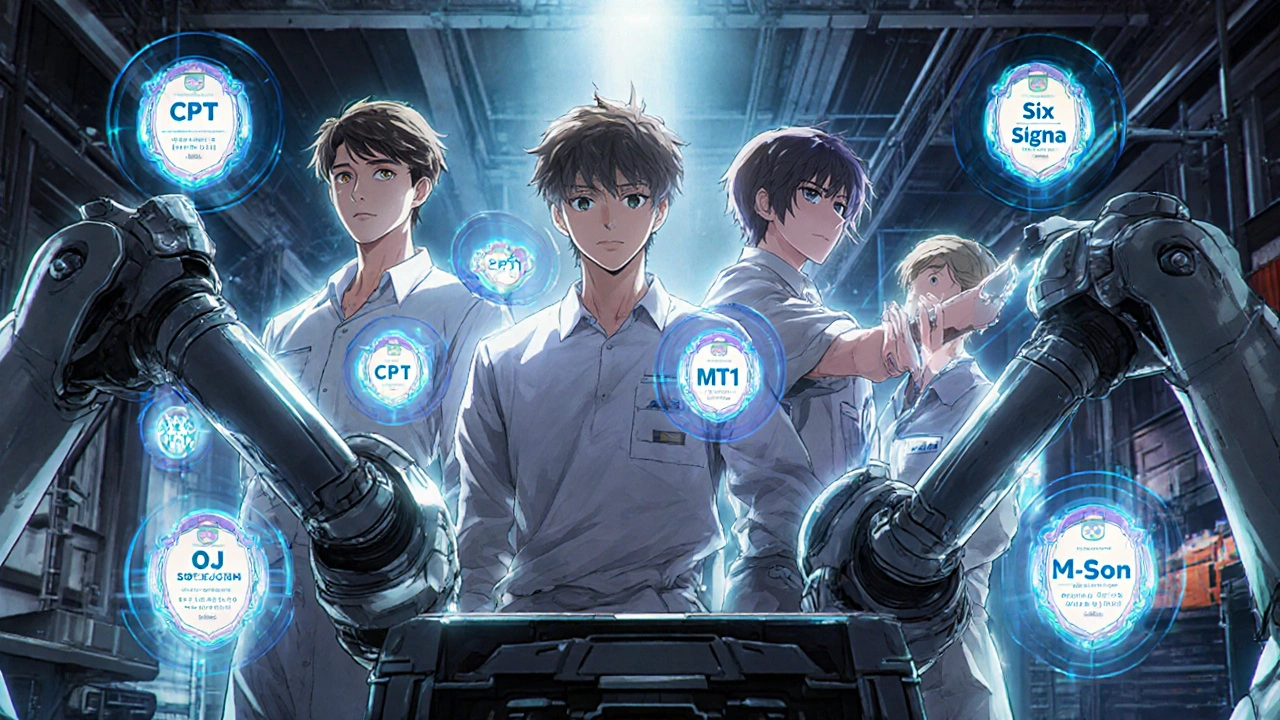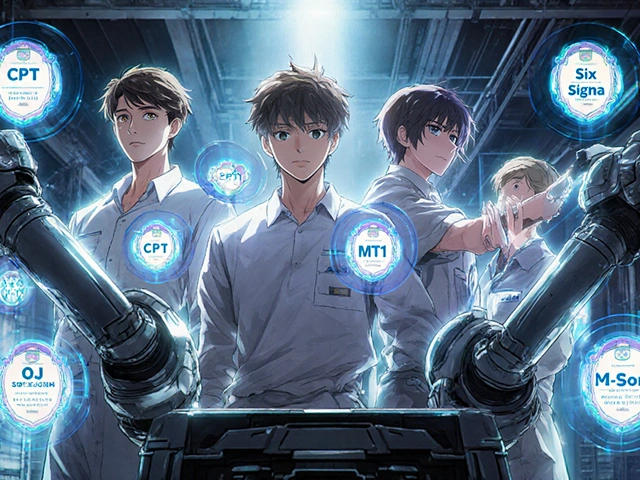Why manufacturing staff qualifications matter more than ever
It’s 2025, and the factory floor isn’t what it used to be. Machines talk to each other. Robots handle precision tasks. Sensors flag defects before a human even sees them. But none of this works without the right people behind the controls. Manufacturing isn’t just about running equipment anymore-it’s about understanding data, following safety protocols, and adapting to constant change. The people on the line are the difference between a smooth operation and a costly shutdown.
Companies that invest in proper training see fewer accidents, less waste, and higher output. OSHA data shows that workplaces with solid safety training cut injuries by 52%. That’s not a small number. It’s life-saving. And it’s not just about safety. Workers with formal certifications are 28% more productive, according to Overall Equipment Effectiveness (OEE) metrics used across the industry. That’s the real bottom line.
What qualifications do manufacturing staff actually need?
There’s no one-size-fits-all answer, but there are clear tiers. Entry-level roles-like machine operators or material handlers-often only require a high school diploma or GED. In fact, 92% of manufacturers accept this as the minimum. But don’t be fooled. Just having a diploma doesn’t mean someone can handle modern equipment. That’s where certifications come in.
For technical roles-welders, CNC operators, quality inspectors-1 to 2 years of college training in fields like Welding Technology or Mechanical Engineering Technology is the standard. These aren’t just classes. They’re hands-on programs that teach how to read blueprints, use precision tools, and troubleshoot common machine errors.
Management and engineering roles? Those usually need a bachelor’s degree in industrial engineering. You’ll need coursework in physics, process design, and quality control. It’s not just about knowing how to fix a machine-it’s about understanding why it broke and how to prevent it from happening again.
The big certifications that actually move the needle
Not all certifications are created equal. Some are fluff. Others are gold. Here are the ones that matter most right now:
- Certified Production Technician (CPT) from the Manufacturing Skill Standards Council (MSSC): This is the entry point for most frontline workers. It covers safety, quality practices, manufacturing processes, and maintenance awareness. It’s nationally recognized, portable, and accepted by over 40 states.
- Six Sigma (White Belt to Master Black Belt): Run by ASQ, this isn’t just about reducing defects-it’s about thinking like a problem solver. Green Belts earn around $85,000 a year. Black Belts? $110,000. The catch? It takes 100 to 240 hours of study and a real-world project to prove you can apply it.
- Manufacturing Technician Level 1 (MT1): Administered by the Manufacturing Skills Institute, this one’s unique because it’s being integrated into high school programs. Over 17 states now fund it for teachers. It’s not as widely known as Six Sigma, but it’s growing fast.
These aren’t just pieces of paper. They’re proof that someone can read a gauge, follow a checklist, and spot a defect before it becomes a recall. And employers notice.

Training that works: What makes a program effective
Training that just sits in a classroom doesn’t stick. The best programs do four things:
- Start with a gap analysis: Look at production data, error rates, and safety incidents. Figure out exactly where the team is falling short. Companies that do this report 33% faster skill improvement.
- Combine hands-on practice with theory: No one learns to operate a CNC machine by reading a manual. They learn by doing it-over and over-with feedback.
- Teach soft skills too: Harvard Business School found that 70% of production failures come from communication breakdowns, not technical errors. Workers need to know how to speak up, ask questions, and report problems without fear.
- Track progress: Use digital skills matrices. Document who’s trained on what. It’s not bureaucracy-it’s accountability. Manufacturers that do this see 27% higher retention.
And don’t forget safety. OSHA’s 1910 General Industry Standards aren’t suggestions. They’re law. Training on PPE, lockout/tagout, and emergency response isn’t optional. It’s required-and it saves lives.
The hidden cost of skipping training
Some companies think training is an expense. It’s not. It’s an investment. But skipping it? That’s a liability.
Entry-level workers without any formal training have a 37% higher turnover rate. That means constant hiring, constant onboarding, and constant mistakes. It’s expensive. Meanwhile, certified workers stick around longer, work smarter, and make fewer errors.
Small manufacturers struggle the most. Sixty-three percent say they can’t afford comprehensive training programs. But here’s the twist: larger companies see a return on their training investment in just 14 months-through less downtime, fewer defects, and lower insurance costs.
And then there’s the digital gap. Sixty-eight percent of veteran workers initially struggle with new digital systems. But cross-training-rotating staff through different roles-cuts that resistance by 41%. People adapt faster when they see how their work connects to the bigger picture.

What’s changing in 2025-and what to expect next
The training landscape is shifting fast. Here’s what’s new:
- AI-powered learning: The MT1 program is testing adaptive learning platforms that adjust to how fast each worker learns. Pilot programs show 22% faster mastery.
- Micro-credentials: Instead of one big certification, workers are earning smaller, stackable badges-like “CNC Operator Level 2” or “Quality Inspection Certified.” By 2025, 63% of manufacturers plan to use them.
- Virtual reality training: Companies are using VR to simulate complex assembly tasks or emergency shutdowns. One Reddit user reported a 39% drop in errors after switching to VR for training.
- Python and SQL are now part of Six Sigma: ASQ updated its 2025 certification to require basic data skills. You can’t just count defects anymore-you need to analyze why they’re happening.
But there’s a warning. MIT’s David Autor says there are now 247 different manufacturing certifications-and too many of them don’t connect to actual job performance. Employers are getting confused. The key is to pick the ones that matter: CPT, Six Sigma, MT1, and safety certifications.
Where to start if you’re new to manufacturing training
If you’re a worker looking to get certified:
- Start with CPT. It’s affordable, widely recognized, and opens doors.
- Check if your employer offers tuition assistance. Many do.
- Look into your local community college. Manufacturing Technology diplomas cost $3,000-$8,000 and have a 91% job placement rate.
- Use free resources: The Manufacturing Extension Partnership has 1,400+ centers nationwide offering free training consultations.
If you’re a manager:
- Don’t just buy training programs. Ask: What gaps are we seeing on the floor?
- Combine certifications with mentorship. ASQ says retention jumps from 57% to 85% when certification is paired with coaching.
- Track results. Measure error rates before and after training. If it’s not moving the needle, change it.
Final thought: It’s not about having the most certs-it’s about having the right skills
Manufacturing isn’t going back to the old way. Automation isn’t replacing people-it’s raising the bar. The workers who thrive in 2025 aren’t the ones with the most certificates. They’re the ones who can think, adapt, communicate, and solve problems. Training isn’t a cost. It’s the foundation of every successful manufacturing operation. Get it right, and you won’t just fill jobs-you’ll build a team that can handle whatever comes next.




David Cunningham
November 22, 2025 at 16:07Honestly? I've seen this play out in Aussie factories too. The real win isn't the certs-it's the culture shift. When workers feel like their input actually matters, they start noticing things no checklist ever could. Just saw a plant in Adelaide cut defects by 40% after they started having monthly 'floor huddles' where anyone could speak up. No managers. Just people talking.
Holly Schumacher
November 24, 2025 at 11:25You say 'CPT is affordable'-but have you checked the cost of the exam prep materials? $150 for a study guide that’s 70% fluff? And don’t get me started on the 'free' MEF consultations-they’re just sales pitches for $2k training packages. This whole thing is a well-marketed scam for training companies.
ann smith
November 25, 2025 at 19:29I’ve worked in three different plants over the last 10 years… and I can tell you: the ones that invested in real training? They’re still here. The ones that cut corners? Gone. 💪✨
Melvina Zelee
November 27, 2025 at 18:08so like… i just got my cPT last month and honestly? it felt like a waste at first. but then i started using the checklist stuff on the floor and my foreman asked me why i was suddenly so good at spotting misalignments. i didn’t even realize i was doing it differently. also, my pay went up $1.50/hr. who knew?? 🤷♀️
Rahul Kanakarajan
November 28, 2025 at 02:39All this certification nonsense. In India, we train guys on the job in 2 weeks and they’re better than most certified Americans. You overthink everything. Just give them a wrench and a chance. No need for 247 badges.
Justin Daniel
November 28, 2025 at 02:42Rahul’s got a point-sort of. But here’s the thing: in the U.S., we don’t have the luxury of 2-week onboarding because the turnover is insane. We need structure. Not because workers are dumb, but because the machines are complex. A certification isn’t a badge of honor-it’s a safety net. And honestly? It’s cheaper than replacing a $200k robot because someone didn’t know how to lockout/tagout.
steve o'connor
November 29, 2025 at 14:58I work in a small Irish plant with 12 people. We don’t have certs. We have trust. If someone messes up, we sit down, fix it, and move on. No paperwork. No exams. Just people who care. The idea that you need a badge to be competent feels… kinda American. And kinda sad.
Danny Nicholls
December 1, 2025 at 01:42vr training is legit. we tried it last year for assemby line drills. my buddy kevin, who used to panic every time the robot moved, now does it in his sleep. he even said it felt like a video game. also, i got a free hoodie out of it. win win 🤖👕
Patrick Marsh
December 1, 2025 at 12:31Python. SQL. Six Sigma. Now you’re asking entry-level workers to code? That’s not training. That’s credential inflation. If you need data analysis, hire a data analyst. Don’t turn every operator into a junior engineer.
Robin Johnson
December 2, 2025 at 06:23Patrick’s right. But here’s the truth: the workers who *want* to learn are the ones who’ll pick up Python. The ones who don’t? They’ll quit anyway. So why not give the motivated ones the tools to rise? It’s not about forcing everyone to be a data scientist-it’s about giving the ones who care a ladder.
New Yorkers
December 2, 2025 at 13:36We’ve been here before. In the 80s, they said you needed a college degree to operate a forklift. Then they said you needed a Six Sigma belt to change a lightbulb. Now it’s Python. The truth? The factory doesn’t need more certifications. It needs more respect. Train people like humans, not like machines. Stop turning the floor into a corporate resume factory.
Julie Pulvino
December 3, 2025 at 16:19I’m a mom of two who got my CPT after my plant closed. I took the class at the community college while my kids were in school. I got hired back at a different plant. Same job. Different pay. Different future. This isn’t about badges-it’s about dignity. And honestly? I’m proud of that paper. It wasn’t easy. But it was worth it. ❤️